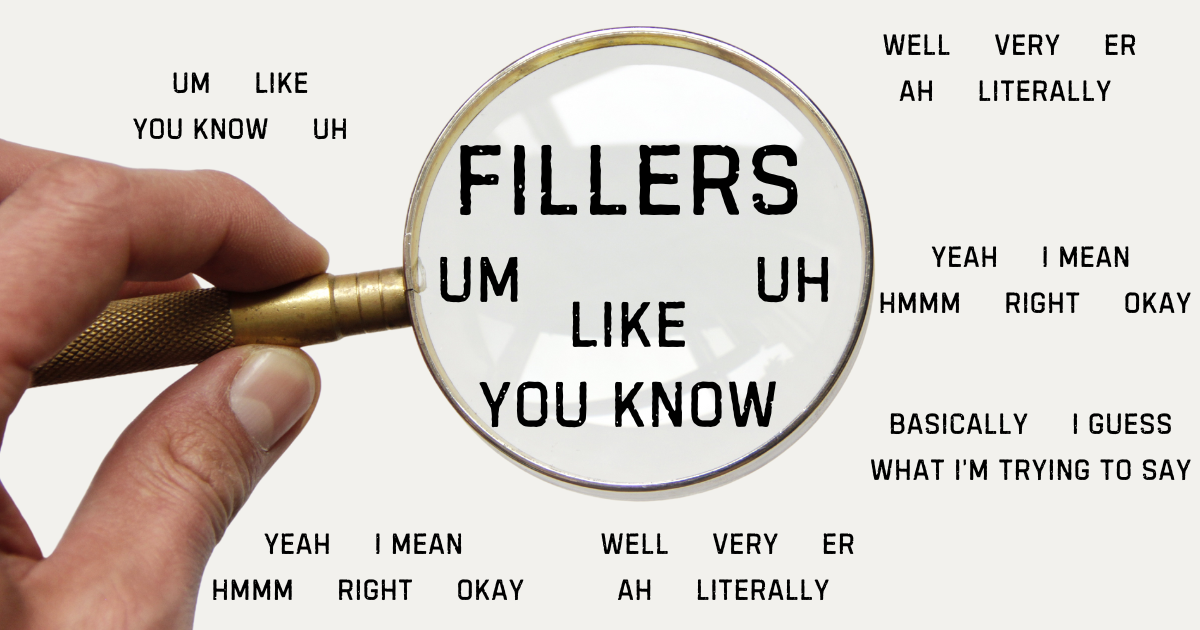How to Bring Filler Words to Your Awareness

Watch Out for Filler Words
Do you know which filler words you say when you speak? You should. To convey your credibility, exude your confidence, and have an audience think of you as more competent and composed, you want to minimize your use of filler words. By the end of this article you will know 3 ways to find filler words.
Filler words are unnecessary verbalized sounds and words that fill your speaking space. These verbal packing peanuts act as extra fluffy filler around your words by taking up necessary verbal space and can cause clutter with the words you do say. Three kinds of filler include sounds, words, and phrases.
You can find out more on the problems that filler words cause and 8 places where filler words come from by reading, ‘How to Make the Right Verbal First Impressions: Reduce Filler Words’.
For the rest of this article the word fillers mean filler words, filler sounds, and filler phrases.
Problems with AI Communication Apps
The influx of new technology to find fillers provides convenience, yet the same technology poses a problem with finding fillers. AI will give what fillers you use but not the reasons why you use fillers. Knowing WHY you use a filler will help more with reducing that filler.
For example, AI determines that you use ‘um’ when you speak. What is causing you to say ‘um’? AI doesn’t know. However, if you explore and analyze what you say by listening back to a recording of yourself you find a pattern where you say ‘umm’ every time you begin a new thought. You now have pinpointed the place where the filler happens, know why you use the filler, and can start reducing the filler. For example, you can always use silence when you finish one thought and give yourself a mental 3 second delay when beginning a new thought. (Read: on 5 tips to reduce fillers)
3 Ways to Bring Fillers to Your Awareness
You only need to do any or all of these 3 ways until you are aware of which fillers you use. Then you want to begin working on reducing and eliminating fillers.
1) Record and Review Yourself
Recording yourself allows you to listen and identify which fillers you use. Record with anything you are comfortable with that will produce a high quality audio. Personally I recommend digital audio recorders due to their simple operation, minimal risk of recording failure, and no setup required (no plugging in, no logging on, no Wi-Fi, no internet, no running an app that requires a software engineer double doctoral degree to operate).
Tips on Listening and Reviewing
Sound quality is important with your recording. Digital audio recorders along with laptops, tablets, and desktop PCs have built in microphones which offer a less crisp and clear audio recording. Both USB and auxiliary jack microphones will provide a more crisp and clear recording. The quality of your audio file is important when transcribing. I have noticed filler sounds missed and filler words translated as other words with low quality microphones which mean your transcribed recording will miss fillers.
When listening back to your recording, make a list of what fillers you use to gain awareness. Rank the frequency of the fillers from the ones you use the most to ones you use the least.
Analyze what happens when you use fillers. Ask yourself questions such as, ‘Why did I use a filler?’, ‘What happened there?’, ‘What did I want to say there?’
Anticipate where fillers occur. 4 common places fillers occur include:
- start of what you are saying
- end of what you are saying
- transitioning between thoughts
- back and forth interaction with people
These 4 spots are locations for verbal traffic jams of fillers. Instead of fluid thought and speech you have starts and stops of your words, the switching between words and thoughts, and exchanges with others.
Besides listening for fillers also listen to how you sound. The sounds of your words reveal symptoms for your fillers. Do you sound nervous, hesitant, distracted, unprepared, or startled? If you can indentify why, then you can begin reducing those fillers.
Overall, the purpose of recording yourself is to get as much feedback as you can to bring fillers to your conscious awareness.
2) Transcribe what you're saying
Transcribing provides the exact words you say when you talk. You can use your audio recordings with transcription software. Additionally there are a lot of online transcription software, phone apps, and video conferencing software with free and premium options. Transcription and video conferencing software records what you say and makes a text file of your recording.
You can find fillers faster with a transcribed file than listening to an audio recording or watching a video. Although apps and software can tell your fillers immediately keep in mind the problems I mentioned above.
A transcribed file saves you time to find fillers when you speak for longer periods of time such as a keynote, workshop, and training. You can scan the transcribed file specifically for fillers.
3) Listening Partner
Another person can identify your fillers as you speak and provide feedback that technology, recordings, and transcription cannot provide. A listening partner provides you feedback in the moment.
You can give your filler list to your listening partner otherwise they will let you know which fillers they hear.
Let your listening partner act as a coach and ask you questions. For example, they hear you say some fillers and ask you, ‘what’s distracting you right now? I noticed you seemed anxious. What’s going through your mind?’
They can also make suggestions. For example, they hear you verbalizing your thinking process with ‘uh’ and ‘um’ and they say, ‘replace the fillers with silence while you think’. Or they may say, ‘you sound uncertain. Gather your thoughts for a few moments. Work through your idea until it makes sense.’
Finally, your listening partner can identify how distracting your fillers are. For example if you speak in longer sentences and have a faster rate of speech your listening partner may think your fillers don’t distract when you speak. However, if you speak in shorter sentences and a slower rate of speech, your listening partner may find your fillers distracting.
In my opinion, if you’re speaking in a conversational style, provide interesting content, or have an energetic delivery, fillers are less distracting than if you are speaking in an info dumping style, provide boring content, or have a lethargic delivery, then fillers are more distracting.
Reduce and Eliminate Fillers
Bringing fillers to your conscious awareness will make reducing and eliminating fillers easier. In time you will start to hear yourself saying fillers which will increase your awareness. I believe you can improve. You can convey credibility and exude your confidence with less of those verbal packing peanuts called fillers the next time you speak. Remember your audience will think of you as articulate, prepared, and intelligent when you reduce and eliminate fillers.
